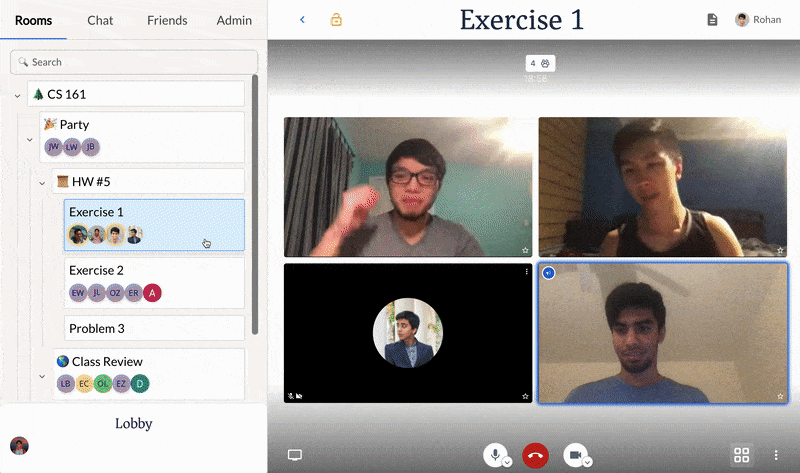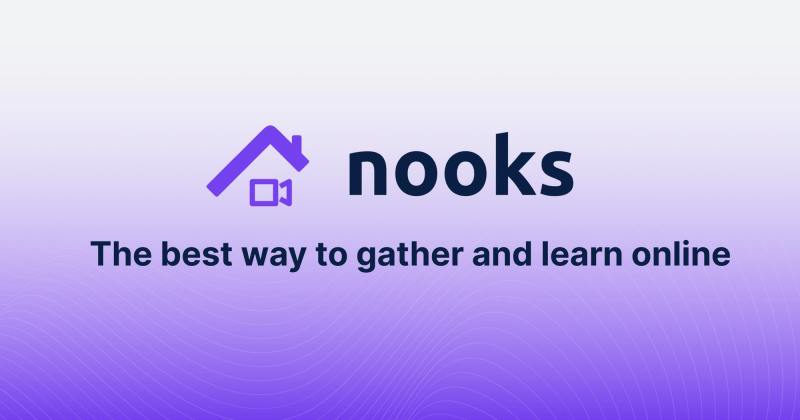Daniel Lee ’21 M.S. ’22, Rohan Suri ’21 and Andrew Qu of Rensselaer Polytechnic Institute (RPI) teamed up to create a new video conferencing software called Nooks, with new features that attempt to outdo Zoom’s capabilities. The platform has been adopted by some colleges and Stanford classes, with the developers hoping Nooks will become more widely adopted nationwide.
Zoom Video Communications, Inc. has seen an unprecedented increase in popularity in the past year as the majority of events and interactions have moved online, even as the company has faced criticism over privacy and security concerns. Google Meet, FaceTime and Skype have not been able to match Zoom’s hundreds of millions of users.
Suri said the biggest advantage of Nooks over Zoom is its user-friendly interface. The app’s landing page boasts that Nooks is “the easiest way to host engaging and interactive workshops, classes, conferences and more.”
Within a Nooks session, there is a sidebar akin to a hierarchical file directory, with rooms nested inside of one another. This design, Suri said, is supposed to feel more natural than Zoom’s.

The Nooks platform also offers features that enable users to have parallel conversations to the main room, which resembles Zoom’s breakout rooms feature. While both Nooks and Zoom allow users to autonomously select a room, instead of being assigned to one by the host, Nooks was first to offer the feature and takes it further by allowing the user to see whom they will meet before entering by using the sidebar. Furthermore, rooms can be generated and sorted based on polls and other criteria.
“We want to actually make online events better than if they were in person,” Suri said.
Rooms can also be locked or have caps on them if, say, a professor (or whoever has an administrative role on the platform) wants to meet with a student one-on-one, one application of which is office hours. In Nooks, professors can set up a queue so that students can wait their turn to enter.
Nooks also allows professors to create different rooms for different questions and invite students to them to chat with one another. In addition to screen sharing and a chat function, users have the ability to integrate spreadsheets, slideshows and other documents directly into the interface.
Collaboration with the computer science department
During the summer quarter, several core computer science classes including CS 103 and CS 161 had the chance to try out Nooks for office hours, and Stanford CS Bridge, a 200-person high school program in Turkey, hosted office hours on the platform.
Nook’s collaboration with the computer science department began when Lee, Suri and Computer Science Department Chair John Mitchell crossed paths at the end of the summer after mutual friends started a conversation. Mitchell and his graduate student Maxwell Bigman Ph.D. ’24 had previously written a research paper about ways educators could improve online learning, and it became clear that they had objectives in common with the Nooks team.
Mitchell and Bigman’s research paper examines the effects of the digital experience on students. The paper recommends that instructors “find ways to strategically combine synchronous and asynchronous elements of their classes” by facilitating meaningful student-to-student interactions, creating psychological safety and integrating the best possible learning tools to support these recommendations.
Mitchell has been helpful in getting the word out about Nooks, according to Suri. Mitchell wrote in an email to The Daily that he was “very impressed” by Nooks, describing it as a “great service to Stanford” for how it addresses concerns he and Bigman raised in their paper.
One of his favorite features, he wrote, is that users can create their own rooms, send invitations, see who is in each room and move between rooms with ease.
Moving between rooms instantaneously for large classes, study groups or office hours, he said, is a benefit unique to online learning.
“I hope Nooks and the University work out a plan so that many classes that are interested can try Nooks this fall,” Mitchell wrote.
As with many digital services, the inspiration for Nooks came from a familiar inconvenience.
Lee took winter quarter off last year to complete an internship in machine learning research and planned to study abroad at the University of Oxford in the spring. Once that was canceled, he said he “didn’t feel like doing online classes,” so he took off the quarter and became interested in video conferencing.
“Lots of my friends were taking classes, and they had complained about watching lectures,” he said, explaining that his friends compared attending live Zoom meetings to watching YouTube videos and that students did not have the opportunity to interact genuinely with professors or nearby classmates.
In transitioning from in-person to online classes, it is easy to lose the flexibility and dynamism of natural, real-life interactions, according to Lee. Normally, there are side conversations, whispering and physical movement. Thus, Lee set out to build Nooks to bring back the diverse threads and layers of conversation in a physical room, in a more authentic way than that facilitated by Zoom.
Beginning in May, Lee and a high school friend started to brainstorm and program, and by the end of June, Suri had also joined the team. Lee had not programmed as a full-stack software engineer — someone who works with websites, servers and databases at once — previously, but he said that he was interested in the project, as it would be a “really good learning experience.” While he said that his Stanford classes have not necessarily directly helped him with the project, he said that the general approaches and problem-solving that he learned from them did help.
Suri, who brings experience with machine learning to the team, said that they want to expand to every campus in the near future by growing the team and marketing more aggressively.
“We’re not just stopping at classes,” Suri said. “We really want to create communities of people learning and sharing how to use Nooks.”
Novel problems require novel solutions, according to Suri. He thinks of Nooks as “Slack for video,” a platform that takes an existing technology and builds on it by adding new features, integrations and a modern user interface.
This fall, Nooks will offer their software for free for all universities.
Institutions like Columbia, the College of William & Mary and RPI have already started using the platform, and Lee expects that many other classes and student organizations will soon use Nooks, as well. Nooks is also working with computer science professor Chris Piech to make Nooks the single platform used in CS 106A lectures and office hours — all of which, the development team believes, will help the platform grow to its full potential and allow the development team to create a more intuitive and engaging product.
“We learn a lot from our users,” Lee said, “they benefit from the platform, and we get to grow without that price barrier. It’s kind of a no-brainer. If it’s better than Zoom, you should just use it.”
This article has been corrected to reflect that Maxwell Bigman is a Ph.D. student, not an M.S. student. The Daily regrets this error.
Contact Matthew Turk at mjturk ‘at’ stanford.edu.
